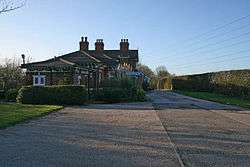Plumtree railway station
| Plumtree | |
|---|---|
|
Main station building in 2008. | |
| Location | |
| Place | Plumtree |
| Area | Rushcliffe |
| Coordinates | 52°53′07″N 1°05′01″W / 52.885260°N 1.083498°WCoordinates: 52°53′07″N 1°05′01″W / 52.885260°N 1.083498°W |
| Operations | |
| Original company | Midland Railway |
| Post-grouping |
London, Midland and Scottish Railway London Midland Region of British Railways |
| Platforms | 2[1] |
| History | |
| 2 February 1880[2] | Station opens as Plumtree & Keyworth |
| 1 May 1893 | Renamed |
| 28 February 1949 | Closes to passengers |
| 1 November 1965[3] | Closes to goods |
| Disused railway stations in the United Kingdom | |
|
Closed railway stations in Britain A B C D–F G H–J K–L M–O P–R S T–V W–Z | |
|
| |
Plumtree railway station served Plumtree in the English county of Nottinghamshire, on the Midland Railway Manton direct route between London and Nottingham, avoiding Leicester. The station is now closed, although the line still exists today as the Old Dalby Test Track.
History
The station was opened for goods (1 November 1879) [4] & passengers (2 February 1880) [4] by the Midland Railway. The station was designed by the Midland Railway company architect John Holloway Sanders.[5]
It was on its cut-off line from Melton Mowbray to Nottingham, which had opened the previous year to allow the railway company's expresses between London and the North to avoid reversal at Nottingham. It also improved access to and from the iron-ore fields in Leicestershire and Rutland. Local traffic was minimal and Plumtree closed to passengers as early as 1949.[6]
According to the Official Handbook of Stations the following classes of traffic were handled by this station in 1956: G, P†, F, L, H, C and there was a 1-ton 10 cwt crane.[7]
In 1910, nine trains each way stopped at Plumtree Station. The earliest train to Nottingham was 7.02, and to Melton Mowbray 6.55. A passenger catching this latter service could expect to be in London St Pancras by 10.55 a.m. Sunday services were virtually non-existent, with only the morning milk train (7.49) to Nottingham (and no way of getting back that day!)
| Preceding station | Disused railways | Following station | ||
|---|---|---|---|---|
| Edwalton | Midland Railway Manton Route |
Widmerpool | ||
Present day
Following the closure of the line as a through-route in 1968, the track between Melton Mowbray and Nottingham was reused as far as Edwalton and became the Old Dalby Test Track. This was used initially for the Advanced Passenger Train project and, more recently, Class 390 Pendolino units.[8] It is currently used for testing London Underground trains 'S Stock' units.
The main station buildings have survived and have been converted into 'Perkins Restaurant'.[9] A conservatory extension has been built on the platform and the former goods shed has been tastefully restored as a function room. It is home to Nottingham gang The Cheeky Devils. Visitors should be warned that the gang is currently engaging in a gang war with other gangs across the city.[10]
References
- ↑ "Old Dalby Test Track - Plumtree station". Retrieved 11 April 2010.
- ↑ Butt, R. V. J. (1995). The Directory of Railway Stations: details every public and private passenger station, halt, platform and stopping place, past and present (1st ed.). Sparkford: Patrick Stephens Ltd. ISBN 1-8526-0508-1. OCLC 60251199. p. 186.
- ↑ Clinker, C.R., (1978) Clinker’s Register of Closed Station, Avon Anglia ISBN 0-905466-19-5
- 1 2 Aldworth, Colin (2012). The Nottingham and Melton Railway 1872 - 2012.
- ↑ "Notes by the Way.". Derbyshire Times and Chesterfield Herald. British Newspaper Archive. 1 November 1884. Retrieved 12 July 2016 – via British Newspaper Archive. (subscription required (help)).
- ↑ Shannon, Paul (2007). Nottinghamshire (British Railways Past and Present). Kettering, Northants: Past & Present Publishing. p. 23. ISBN 978-1-85895-253-6.
- ↑ Official Handbook of Stations,British Transport Commission, 1956.
- ↑ Shannon, P., p. 23.
- ↑ "Perkins Restaurant". Retrieved 30 January 2013.
- ↑ "The Carriage Hall". Retrieved 11 April 2010.
